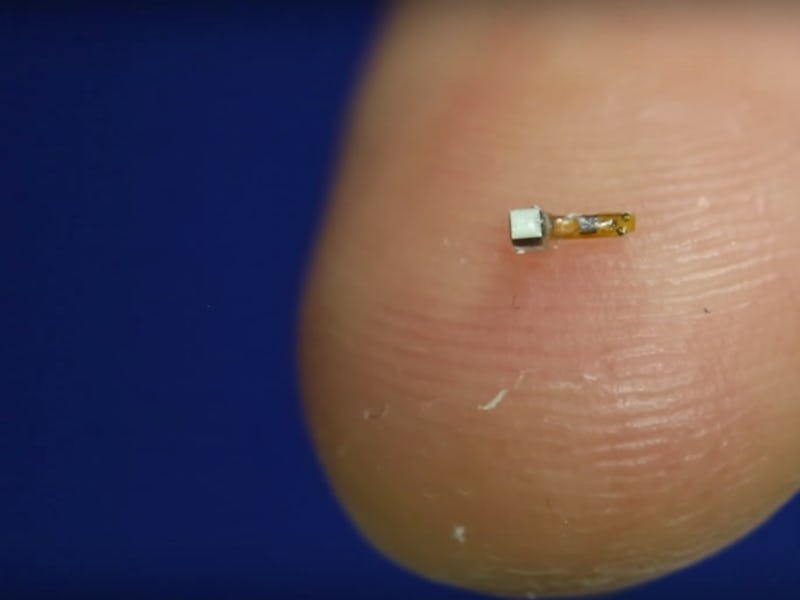Engineers Develop "Neural Dust" That Will Replace Your Fitbit
Future iterations of neural dust could remain inside a person, unnoticed for decades.

The engineers who developed the system call it “neural dust.” It’s a great name. If they ever tire of being groundbreaking innovators, they could probably shift over to marketing.
The team working out of the University of California, Berkeley headed by José Carmena, a neuroscientist, and Michel Maharbiz, an electrical engineer, first theorized the possibility of millimeter-sized implants — powered by ultrasound — in a 2013 paper published in the journal arXiv. Now, through proof-of-concept experiments, they may have revolutionized the future of implantable medical monitoring devices.
In their paper published in the July issue of the journal Neuron, Maharbiz’s team describes how they were able to connect tiny sensors to a rat’s sciatic nerve to monitor impulses in real-time. “The big ‘ah-ha’ was that we realized that building a system that used ultrasound allowed us to build extremely small devices,” Maharbiz tells Inverse. “The ones we demonstrated were a millimeter in size or so and we are aggressively miniaturizing them now.” While tiny is cool, it doesn’t do much good if the data can’t be extracted and used.
Neural dust is so promising because, in the words of Marharbiz, “Your body is pretty transparent to ultrasound. We’re extremely excited that ultrasound worked out as well as it did. It really does look like you could build really small implants this way, and it increasingly looks like you could modify the device to do all sorts of stuff.”
“You could place these anywhere”
His excitement is palpable when talking about the many different applications this tech could be adapted to perform: “You could place these anywhere and they could report back things you want to measure about organs, like pressure, pH balance, and oxygen levels. You could use them to interact with prosthesis or provide nerve stimulation to treat bladder and muscle control problems,” but he cautions these are long-term goals.
In the near-term Maharbiz’s team is already working to refine the sensor’s ability to read individual neurons, rather than the gross firings of nerve clusters. They’re also working to add functionality to the circuit to create nerve stimulation capabilities, a necessary step in creating a closed-loop system required for wireless man/machine interfaces.
Such breakthroughs could allow more freedom of motion to people like Erik. He is unable to move his muscles, so current tech available to people like this Marine, won’t work for him. The interface option for Erik operates through wires threaded to neural implants through holes in his skull, which is not ideal. The hope is, neural dust could one day make those wires obsolete.
All of this is all made possible by special crystals. These rocks, called piezoelectric crystals, are unique in that they generate a small current of electricity when their shape is distorted. Another component of the system, a slightly bigger (0.8x1x3 mm) implant, called a mote, is placed just under the skin and produces the ultrasound vibrations to create this effect. The crystals vibrate, distort, and power the tiny circuit on the particulate-sized sensory equipment.
When the circuit registers an action on what it’s monitoring, it reverses the process. It makes a slight alteration to the crystal’s vibrations and that change ripples back through the waves of ultrasound back to the mote, then to a transceiver outside the body and finally a computer that processes the signal — kind of like how sonar sends information back to a submarine.
Diagram of one of the tiny sensors.
Since there are no wires, and/or internal battery sources, these devices don’t damage the body or activate immunological defenses as much as current, bigger technology. Theoretically, future iterations of neural dust could remain inside a person, unnoticed, for years, even decades, and provide real-time feedback of what’s going on inside, informing on the treatment of any number of ailments.
All excitement and sci-fi applications aside, Maharbiz cautions restrained enthusiasm among people interested in the technology, “I’m getting emails all the time, people asking me to volunteer.” He stresses the need for safety protocols, durability tests, and clinical trials and that cyborg abilities are a long way off.
“While the medical applications are potentially very large, we are just beginning down this road.” This first-of-its-kind tech is promising, but we’re a long ways away from neural dust checkups at our next doctor’s visit.